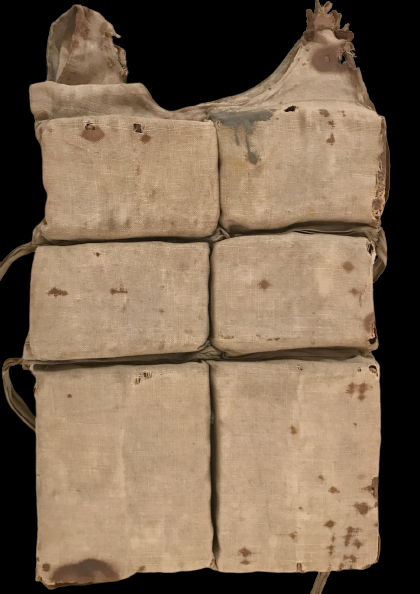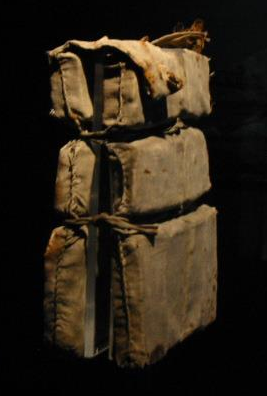Lifebelt saved by William F. Johnson
For the grim task of recovering the bodies of Titanic's victims, many undertakers from Halifax and the surrounding towns and cities were asked to assist. William Johnson, an employee for Farquanar Bros., based in Halifax, volunteered to help the Mackay-Bennett’s crew. Farquanar Bros. supplied electric equipment to vessels, including the cable ships which were harbored in Halifax. Mr. Johnson told his grandson that the reason he volunteered at the time was because some of the Mackay-Bennett’s crew were not keen on going as the body recovery was to be grim, and since the men from Farquanar frequently serviced these ships, they were familiar with the vessels and would be able to help operate them efficiently. Furthermore, Mr. Johnson stated that when they retrieved the bodies, the knots binding the straps of the lifebelts were not only waterlogged tight but also frozen solid. So, in most cases, the lifebelts had to be cut from the corpses and thrown onto a stack on the deck of the ship. It was from this pile that Mr. Johnson took this lifebelt as a memento. It found its way into the hands of collector Steve Santini who passed it on to Titanic collector Stanley Lehrer. For a while it was on display at the Pigeon Forge / Branson Titanic Museum Attraction. Since November 2022 it has been on loan to "Titanic. The exhibition" in New York City until early September 2023 with an option to prolong.
According to the Washingtonian the lifebelt moved with the exhibition to Maryland’s National Harbor. The exhibition opened there on October 21st 2023 and was on display until December 10th 2023.
Stains
Sometimes the stains on this lifebelt are described as oil or rust stains, but it is also likely they could be blood stains as some of Titanic’s victims were found with broken jaws and necks. The reason for this is that when a passenger jumped from the sinking ship into the water, the buoyancy of the cork-filled lifebelts made them float immediately, while the wearer slipped down into the lifebelt due to there being no strap between the legs, causing the chin to be hit by the hard cork underneath being quickly thrust upward and the head to be knocked backward, hence breaking the wearer's jaw or even their neck. This design of lifebelt eventually became known as “jawbreakers” and was discontinued shortly afterward.
It is questioned whether the lifebelts were actually lifesavers in this video by the Titanic Channel.



Above, the lifebelt saved by a Farquanar employee. It was cut off a Titanic victim at the shoulder straps a both halves were saved.
Left and middle photos, Pigeon Forge / Branson Titanic Museum Attractions.
Right photo by Neil Adrian Smith (2003).
On the inside of the lifebelt there was an inscription indicating that this lifebelt came from Titanic.
This inscription became known when the lifebelt was displayed inside out during "Titanic. The exhibition" in New York City.
The inscription shown here is slightly drawn over to enhance the writing.
Photo Pigeon Forge / Branson Titanic Museum Attractions.

Maak jouw eigen website met JouwWeb